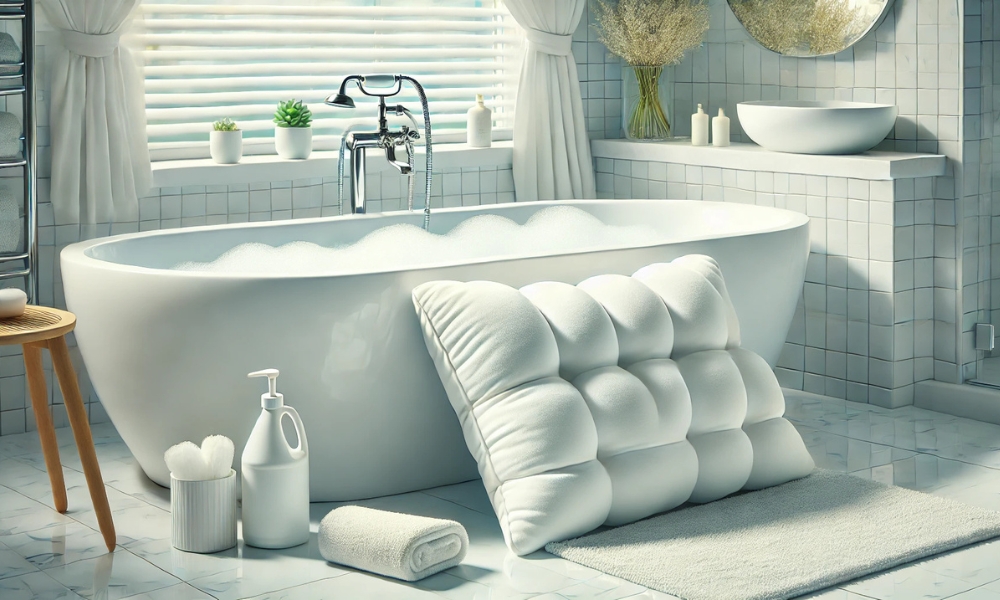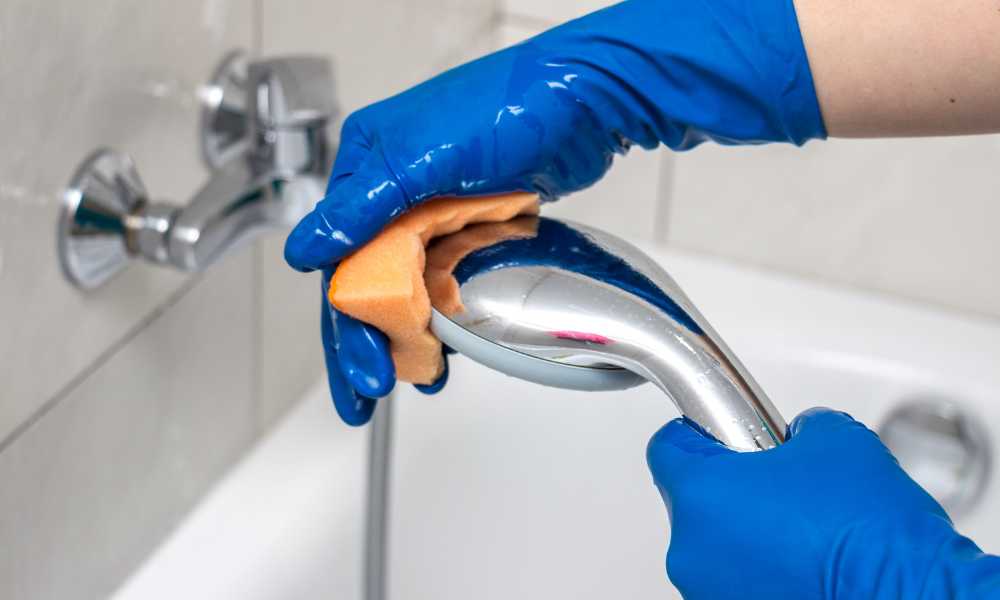Bath Pillow Wash — they’re the epitome of bathing comfort, cradling your head and neck in a cocoon of support. Yet, these luxurious pillows can become a breeding ground for musty odors and mold if left uncleaned. Bath pillows, constantly exposed to water, oils, and soap residue, require a little care to stay fresh and inviting. A well-maintained bath pillow doesn’t just elevate your bathing experience; it keeps things clean and hygienic. Here, we’ll walk you through a meticulous process to keep your bath pillow as fresh as the day you bought it.
1. Understanding Bath Pillow Material
Every bath pillow is unique. Made from materials like memory foam, mesh, or inflatable plastic, each type has its quirks and requirements. Memory foam pillows absorb water deeply, demanding more thorough drying, while mesh pillows allow for better airflow and faster drying. Knowing your pillow’s material type is the first step toward picking the right cleaning method, one that ensures cleanliness without causing damage.
2. Checking The Manufacturer’s Instructions
Read the tag. Always. Each pillows may have unique washing requirements, temperature limitations, and detergent guidelines. Manufacturers often outline the safest cleaning practices specific to your pillows model. Adhering to these can make all the difference in preserving its softness, structure, and longevity.
3. Gather Necessary Supplies
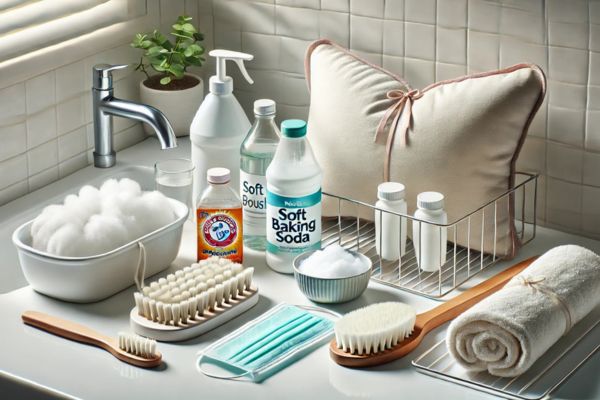
Ready your arsenal: a mild detergent, soft brush or cloth, baking soda, white vinegar, and perhaps a drying rack. With everything within reach, you’ll streamline the cleaning process, making it efficient and precise. Organization is half the battle, especially with delicate items like bath pillows.
4. Inspect The Pillow For Stains Or Mold

Give your pillows a close look. Look for discolorations, patches of mildew, or sour odors — signs that some areas need targeted treatment. This inspection is essential; it reveals where you might need to apply a more intensive cleaning technique before moving on to the general wash.
5. Prepare A Soapy Solution For Hand-Washable Pillows

Hand washing is the gentlest approach. Create a soapy solution by combining warm (not hot) water and a bit of mild detergent. Hot water risks damaging delicate materials and can cause colors to fade. This warm, sudsy bath will break down grime without compromising the pillow’s integrity.
6. Spot Cleaning Tough Stains
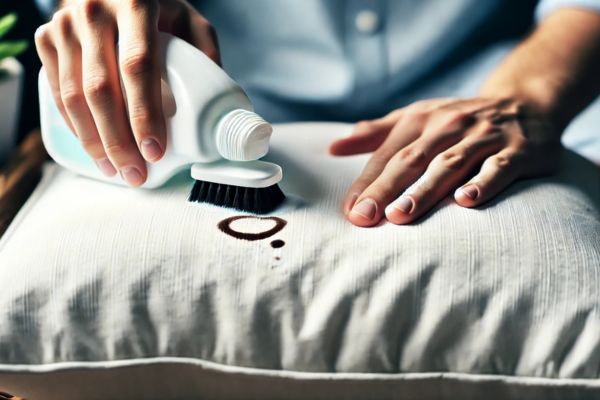
For stains that resist regular washing, apply a small dab of detergent directly to the stained area. Gently scrub using a soft brush. This step requires patience; aggressive scrubbing can easily damage the fabric. Let the detergent sit for a few minutes if needed, then continue with light strokes until the stain fades.
7. Machine Washing The Pillow (if Allowed)
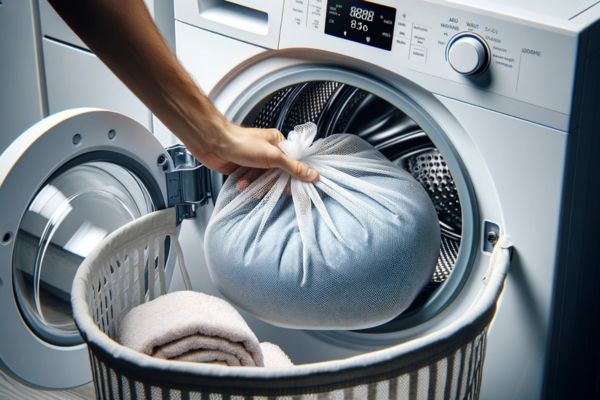
Some pillows are machine-washable. If your pillow’s tag permits it, use a mesh laundry bag to protect it from intense agitation. Opt for a gentle cycle and cold water. Avoid spin cycles as well, which can be too harsh for delicate bath pillows and may lead to misshaping.
8. Adding Baking Soda For Odor Control
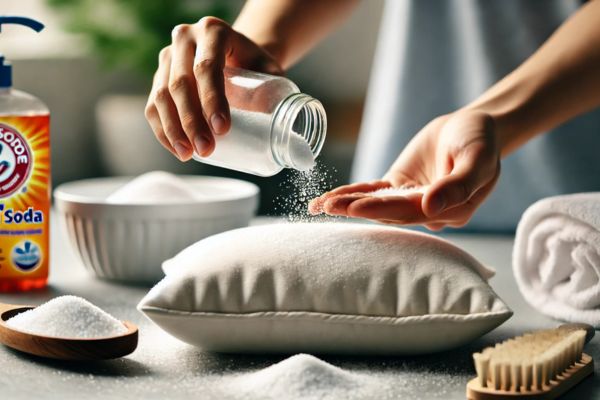
Odors often cling stubbornly to bath pillows. Sprinkle baking soda liberally over the surface, allowing it to absorb unwanted scents for a few minutes before washing. This natural deodorizer refreshes the pillows, making it smell as good as new.
9. Using White Vinegar For Disinfection (Optional)

White vinegar can be your secret weapon for a cleaner, fresher pillow. Known for its natural disinfecting properties, vinegar can be added to your soapy solution or directly into the washing machine. Just half a cup will do; it breaks down residues, disinfects, and deodorizes in one go. Ensure your pillows material can handle vinegar, as some might not be compatible.
10. Rinsing The Pillow Thoroughly

After washing, rinse the pillows thoroughly in cool, clear water. This final rinse is crucial, as any lingering detergent or vinegar can lead to irritation or unpleasant smells. Repeat until the rinse water runs crystal clear.
11. Gently Wring Out Excess Water (for Hand-Wash)
If you’re washing by hand, carefully press out any excess water. Avoid twisting or pulling. Instead, use a gentle squeezing motion to release trapped moisture. Aggressive handling can harm the material or cause it to lose shape, so go easy.
12. Using a Clean Cloth to Blot Excess Water
Following the squeeze, take a clean, absorbent cloth and lay it over the pillows. Lightly press down to draw out any remaining water. This blotting step speeds up the drying process while keeping the pillow’s form intact.
13. Avoiding Direct Sunlight During Drying
Direct sunlight might seem ideal, but it can be damaging to delicate pillow materials. Opt for a shaded area, allowing the pillows to air-dry naturally. This approach protects against fading, hardening, and potential material degradation.
14. Placing The Pillows On A Drying Rack

A drying rack allows air to circulate evenly, accelerating drying while helping the pillow maintain its shape. Position it on the rack to prevent water from pooling in one area. The open structure of a rack ensures every part of the pillows dries evenly, preventing mildew or odors.
15. Speeding Up The Drying Process (Optional)
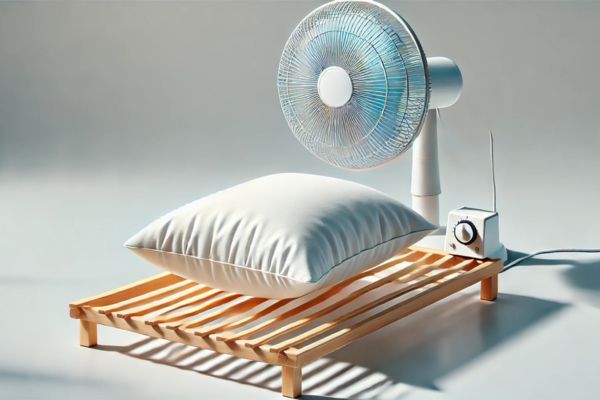
To speed things along, you can set a fan on a low setting directed toward the pillow. This airflow encourages faster evaporation without disturbing the pillow’s shape. It’s an optional step, but it’s helpful for thicker materials that retain moisture.
16. Checking For Complete Dryness
Press the pillows surface; if it’s completely dry, it’s ready for use. Residual dampness can lead to mold or mildew. So, don’t rush this check—damp spots might be lurking within, hidden from the surface but harmful if left untreated.
17. Deodorizing Between Washes
Keep your pillows smelling fresh by using a light layer of baking soda between washes. Let it sit for an hour before brushing it off. This regular deodorizing will absorb residual moisture and oils, extending the time between deeper cleans.
18. Cleaning and Sanitizing Suction Cups (if Applicable)
If your pillow includes suction cups, they need attention, too. Detach them and wash in warm, soapy water, scrubbing to remove any buildup. Rinse and dry them completely before reattaching. Clean suction cups will help the pillows maintain a secure hold, preventing slippage.
19. Routine Maintenance Tips
Quick maintenance can prolong your pillow’s lifespan, preserving its comfort and cleanliness. After each use, rinse the pillow in clean water and hang it to dry. This quick rinse removes surface oils, soap, and other residues that accumulate over time.
20. Storing the Pillow Properly
When it’s not in use, store your bath pillow in a dry, ventilated space. A humid bathroom environment will only invite mold. Use a breathable bag if it will be stored for an extended period, giving it plenty of airflow to prevent mildew.
Conclusion
A clean bath pillow turns an ordinary bath into a sanctuary. By following these steps, you’ll extend the life of your pillow and enhance the overall bathing experience. Embrace a regular cleaning routine to keep this small luxury feeling fresh, inviting, and as indulgent as the day you bought it. After all, a bath pillow should be a pleasure, not a chore.
